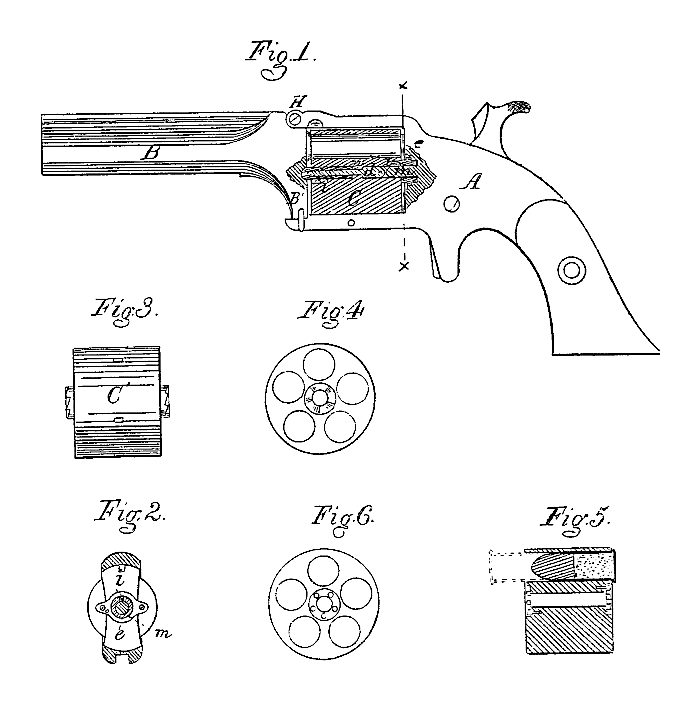US 59629
UNITED STATES PATENT OFFICE.
ALBERT L. MUNSON, OF NEW HAVEN, CONNECTICUT, ASSIGNOR TO HIMSELF AND ARTHUR MOFFATT.
IMPROVEMENT IN REVOLVING FIRE-ARMS.
Specification forming part of Letters Patent No. 59,629, dated November 13, 1866.
To all whom it may concern:
Be it known that I, A. L. MUNSON, of the city and county of New Haven, and State of Connecticut, have invented certain new and useful Improvements in Revolving Fire-Arms; and I do hereby declare that the following is a full, clear, and exact description of the same, reference being had to the accompanying drawings, which form part of this specification.
My invention relates to fire-arms that have a many-chambered revolving cylinder.
It consists in so constructing said cylinder that it can be reversed and applied to the frame (both ends being made alike) so that in loading the chambers in the cylinder by inserting the cartridge in one end thereof the cartridge shell is ejected from the other end.
Figure 1 represents a fire-arm, a portion of which is shown in section, illustrating my improvement. Fig. 2 is a cross-section of the same, taken on the line x x, Fig. 1. Fig. 3 is a side view of a cylinder embracing my improvement in another form. Fig. 4 is an end Fig. 5 is a sectional view of a cylinder, showing another modification.
Similar letters of reference indicate corresponding parts.
I will now describe what I consider the best means of carrying out my invention.
A represents the frame of a fire-arm. B is the barrel; B’, a projection from the barrel which supports one end of the center-pin d. e is a ratchet wheel of disk, detached from the cylinder C, and held in place on the pin m by means of a plate, o; or its equivalent, as shown in Fig. 2.
i’ is a small pin projecting from the ratchet-wheel or disk e, which fits into a hole in either end of the cylinder C, locking the cylinder to the ratchet-wheel, so that they will revolve together.
The center-pin d is constructed in two parts, and connected together by means of a screw-thread on the end of the connecting rod or neck, which is made of less diameter than the pin d, forming shoulders on the pin, which limit its movement by coming in contact with the projection n on the cylinder C.
Figs. 3 and 4 and 5 and 6 represent cylinders having a ratchet arrangement on each end. In that shown in Figs. 3 and 4 the ratchet projection, which is of the ordinary and well known form, could be used as a center-pin for the cylinder C to revolve on. In Figs 5 and 6 the ratchet arrangement is made of projecting pins placed in a recess in each end of the cylinder, flush with its face, and corresponding with the number of chambers. This arrangement of the ratchet renders my improvement applicable to many varieties of fire-arms.
The operation of my improvement, applied as represented in Fig. 1 is as follows:
After the revolver has been fired, the barrel is moved back by means of the hinge H. and the cylinder C removed. The cartridges are then inserted into the open end of the chambers, forcing the empty cartridge-shells outward, as shown in Fig. 5, (the cartridges thus acting as a cartridge-shell ejector.) The cylinder is then reversed and placed back into the frame. The movable center-pin d, coming in contact with the pin m, is forced backward until its shoulders come in contact with the projection in on the cylinder C. At the same time the cylinder C is turned until the pin i enters the hole i’. The barrel is then moved into position, and the arm is ready for use.
Having thus described the nature, construction, and operation of my invention, what I claim, and desire to secure by Letters Patent, is–
1. The reversible cylinder C, in combination with the detached ratchet e and plate (or collar), o, or its equivalent, substantially as and for the purpose described.
2. The center-pin d, in connection with the pin m, operating substantially as and for the purpose described.
In testimony whereof I hereunto sign my name this 10th day of May, 1866.
ALBERT L. MUNSON.
Witnesses:
W. G. TOMER,
JOSEPH R. COBB.

